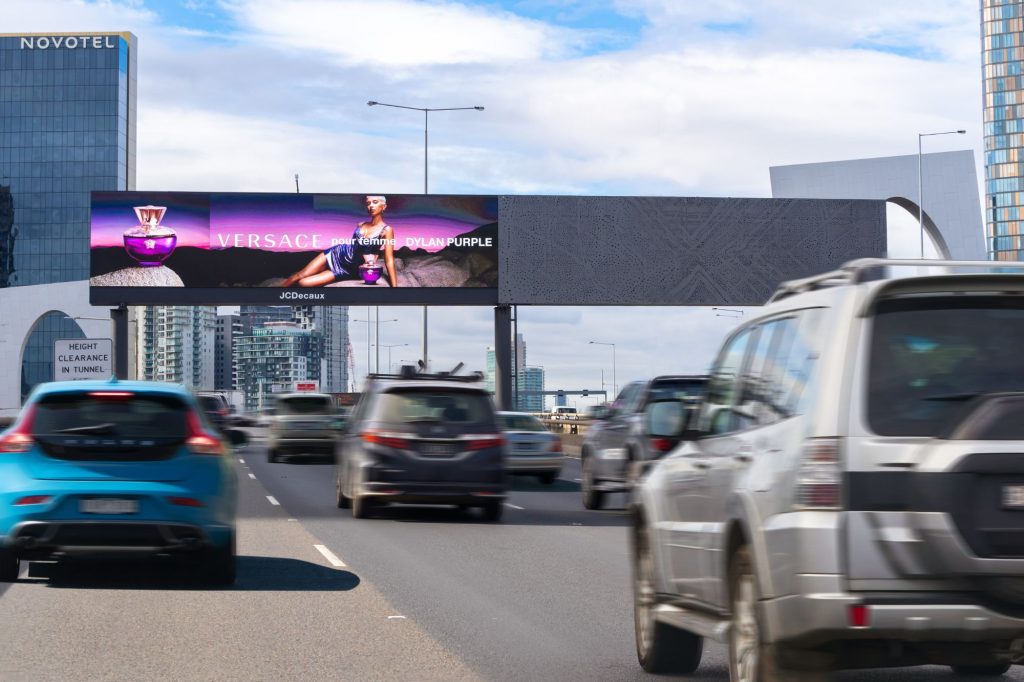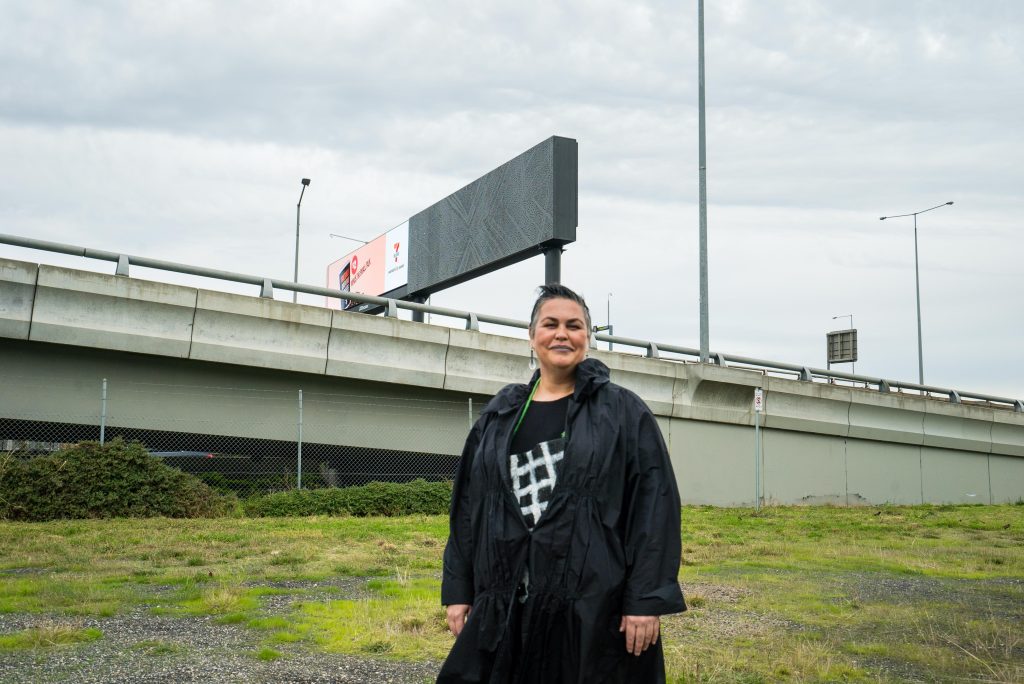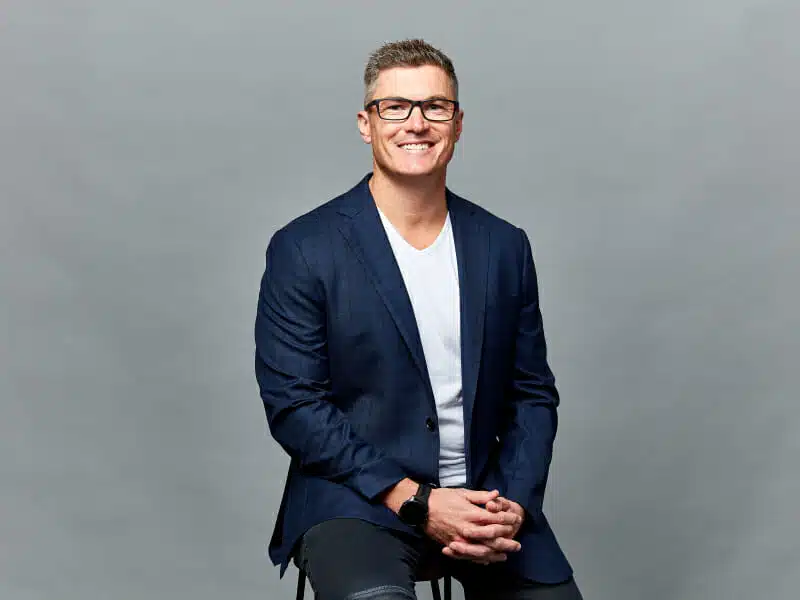
Tilt Industrial Design and Lisa Waup deliver Australia’s first large-scale Indigenous public art via out-of-home advertising
Tilt Industrial Design and Lisa Waup deliver Australia’s first large-scale Indigenous public art via out-of-home advertising
Share
How We Work: Tilt Industrial Design’s founder and creative director Tim Phillips and multidisciplinary artist Lisa Waup discuss with Australian Design Review (ADR) how they worked together to deliver Australia’s first large-scale Indigenous public art concept via out-of-home advertising.
When it comes to designing public art, Tilt Industrial Design founder Tim Phillips and multidisciplinary Indigenous artist Lisa Waup understand the importance of considering time, space, material, and who the intended audience is.
The pair collaborated on delivering a large-scale Indigenous public art installation, to sit alongside a large-scale out-of-home billboard over one of Melbourne’s most frequented roads, the Westgate Freeway. Named pathed between, the artwork consists of two installations, each 20 metres wide, portraying cultural meanings of family and community, with the interwoven design representing the pathways on which we travel. JCDecaux partnered with the Department of Transport, and Authority Creative in consultation with the Wurundjeri Woi Wurrung Aboriginal Corporation to commission the bespoke piece of art.

The unique piece exists as Australia’s first original piece of Indigenous public art installed and connected via out-of-home advertising for JCDecaux.
JCDecaux couldn’t be happier with the outcome.
“This is a monumental moment for our organisation,” a spokesperson says.
“We’re very proud to have partnered with the Victorian Department of Transport and Planning and the Wurundjeri Woi Wurrung Cultural Heritage Aboriginal Corporation to unveil Australia’s first original Indigenous artwork that will feature permanently next to our new Digital Large Format screen on Melbourne’s West Gate Freeway.”
Phillips and his team collaborated with Waup, to create a captivating artwork that seamlessly integrated with the site while preserving the artist’s vision.
This collaboration highlights the challenges and rewards of working in the public domain, especially when incorporating work by First Nations artists and their unique storytelling approaches.
“Typically when we’re designing a public artwork of any type, you try to consider the perspective of the individual who would enjoy it,” Phillips reflects on the project’s challenges.
“For this Indigenous public art, on the entry to the West Gate Bridge, you have it as a long distance experience, and then you are up close to the artwork, then it’s gone. And we can’t be too distracting either. We have to create an artwork that’s appealing without having too much appeal!
Waup agrees that there were some challenges with the physical space, but the sense of accomplishment outweighs any difficulties encountered.
“I think it’s been an incredible experience for me to be part of this project,” she says.
“It’s the biggest piece of Indigenous public art I’ve ever created. So to see it at that scale, and in that position – I get such a thrill every time I go by to be honest!
“I think it’s really important, especially, for First Nations people, but also for non-Indigenous people to have vision of us around. To see most First Nations art, you would go to the museum or an art gallery, but we are bringing it to places where people probably wouldn’t normally interact.”

Phillips emphasises the importance of understanding the ambitions of the artist while navigating the design and manufacturing possibilities and limitations. The goal is to ensure that every stakeholder considers the project a success, both artistically and commercially.
In the case of Waup’s artwork, the design criteria were defined by the site and the materiality, with aluminium chosen for its durability.
Phillips and his team focused on finding an artistic concept that would translate well into the specific location, taking into account the manufacturing and design constraints.
Authority Creative, the curatorial team, recommended a number of different artists that could put forward concepts for consideration. They provided guidance to help select a concept that aligned with both the artistic vision and the project requirements.
The unique aspect of Waup’s artwork was the incorporation of irregular, non-circular perforations. Tilt Industrial Design worked closely with Waup to develop a design methodology and manipulate materials and manufacturing processes to achieve the desired organic outcome.
Departing from conventional geometric approaches, Phillips and his team strived to create a design that felt like Waup’s work, not a machine adaptation.
“We felt that Lisa’s work would translate well, and we could do justice to the intent,” Phillips says of the design process.
“I think the big moment for us in working with Lisa was when we departed from circles to irregular shapes, organic design and suddenly the work started to feel like Lisa’s work and not a machine adaptation of the artwork. That’s the success for us – when we can make an artist feel like the works that are produced on their behalf could have actually been made by hand, in the sense that they are by the artist and not by a machine dictating the outcome.”

Waup says a lot of people were part of this collaboration.
“To have this realisation of this work, that has been respected, heard and listened to and then for it to be a part of this place, has been a dream come true to be honest.”
During the collaboration, the dialogue shifted from materialism and manufacturing processes to the experience of the person observing the artwork. For Waup, the human experience was the driving factor behind the project, along with prioritising storytelling and communication with the audience when making design decisions.
“It had many stages, originally it started off as a drawing. I’ve got this visual diary, I’ve been drawing in it for years and years. Then the drawing was translated into an etching. And then from the etching, the final artwork,” says Waup
“I’m a contemporary artist. So a lot of the stories are about the present and it’s also talking about my connection to my history and my family. It’s the idea of embedding a place in a drawing. It was 2D and then it became almost animated. You’ve got to drive past it and it flicks through light and looks incredibly beautiful and industrial.
“Something that’s quite tactile has become this industrial metal finish. It was just an incredible experience to see the translation from its early stage to where it is now,” she adds.
The collaboration with Waup and other First Nations artists has been a learning experience for Phillips and his team. They have gained insights into diverse cultural experiences and had the opportunity to hear stories that would have otherwise remained untold. Working together as a team, combining industrial design, Indigenous public art, and storytelling, leads to a more powerful and meaningful outcome.
“It’s an amazing opportunity to learn, hear stories like Lisa’s and get exposed to cultural experiences that I never really expected to,” Phillips says.
“It’s about forming a team that can deliver a great story while we address all those commercial challenges,” he adds.
“I genuinely feel like I’m back at uni in year one, having this entire cultural education. And it’s not just learning about First Nations stories. It’s about how we as an industry use landscape architecture and public art, and can come together for a better combined outcome than if we treated those objectives separately. The Connecting to Country framework in New South Wales is driving our significant projects, engaging with First Nations artists, landscape architecture, architecture and art to celebrate the stories of the country. It’s a recurring theme of past, present and future.”
The groundbreaking pathed between artwork exemplifies the power of combining commercial objectives with storytelling and historical significance. The collaboration between Tilt Industrial Design and Lisa Waup also demonstrates the delicate balance between respecting the artist’s vision and meeting project requirements.
By weaving together the expertise of designers, the vision of artists, and the stories of the land, these collaborations create spaces that resonate with meaning and emotion. As communities engage with these artworks, they are given the opportunity to connect with their surroundings, reflect on their shared heritage, and forge new narratives for the future.
Through their collaborations, Tim Phillips and Tilt Industrial Design, and Lisa Waup are paving the way for a more inclusive and vibrant Indigenous public art landscape in Australia.
You Might also Like
























